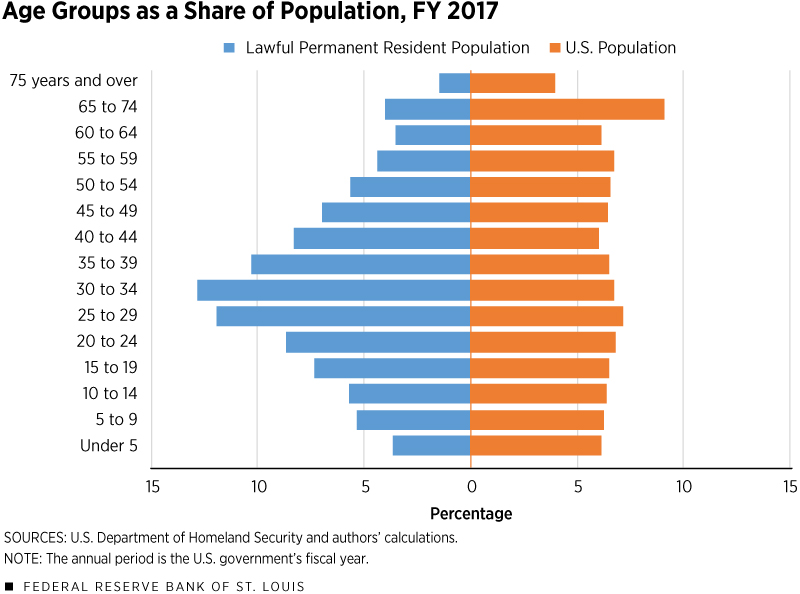Who Holds a Green Card?
The demographics of those who are legal permanent residents, better known as green card holders, will have an impact on the makeup of the future of the U.S. workforce, according to a recent Regional Economist article.
Economist Subhayu Bandyopadhyay and Research Associate Asha Bharadwaj analyzed relevant traits of legal permanent residents (LPRs) to better understand how they might affect Social Security and the availability of skilled workers, among other effects.
Green Card Recipients
In their analysis of data from the U.S. Department of Homeland Security, Bandyopadhyay and Bharadwaj found that immediate relatives of U.S. citizens received the greatest number of green cards from fiscal years 1986-2017. The second largest group was family-sponsored immigrants, including adult children of U.S. citizens and the spouses and children of LPRs. The third largest group comprised employment-based preferences. Aimed at attracting a talented, skilled workforce, this group is composed of immigrants who are top-performing professors, researchers and other professionals. Refugees, asylum seekers and citizens of other countries with low numbers of U.S. immigrants, among others, make up the smallest categories.
Where Immigrants Come From
Mexico is the single largest point of origin for LPRs to the U.S, with nearly 171,000 green cards granted in 2017, Bandyopadhyay and Bharadwaj observed. Mexico has led the number of green card recipients annually since 1989, at 20.5%. However, the share of green cards received by Mexicans in the decade ended in 2017 is lower (14.4%) compared with the overall share from 1989 to 2017. China (5.7%), the Philippines (5.4%), India (5.3%) and the Dominican Republic (3.6%) follow Mexico as the major sources of LPRs over the 1989-2017 period.
Careers They Represent
The types of occupations that LPRs hold are diverse. Nearly a quarter of green card holders—the largest segment—are students or children (23.6%), followed by homemakers (12.7%). Since the immediate relatives (spouses and dependent children) of U.S. citizens are automatically eligible for and get preference for permanent residency, the size of this group stands to reason, the authors noted.
The largest employed group comprises management, professional and related occupations (10.1%), which follows the preference for skilled workers.
| People | Percentage | |
|---|---|---|
| Students or Children | 266,526 | 23.6% |
| Homemakers | 143,149 | 12.7% |
| Retirees or Unemployed | 115,889 | 10.3% |
| Management, Professional and Related Occupations | 114,218 | 10.1% |
| Production, Transportation and Material-Moving Occupations | 42,745 | 3.8% |
| Sales and Office Occupations | 41,284 | 3.7% |
| Service Occupations | 28,021 | 2.5% |
| Construction, Extraction, Maintenance and Repair Occupations | 12,867 | 1.1% |
| Farming, Fishing and Forestry Occupations | 12,594 | 1.1% |
| Military | 44 | 0.0% |
| Unknown | 349,830 | 31.0% |
| TOTAL | 1,127,167 | |
| SOURCES: U.S. Department of Homeland Security and authors' calculations. | ||
| NOTE: The annual period is the U.S. government's fiscal year. | ||
Green Card Holders by Age
From an economic impact perspective, the study’s authors were encouraged by the large numbers of students and children who receive green cards. This is important because the baby boom generation is at or close to retirement age and eligible to receive Social Security benefits.
“Today’s students can contribute to a skilled future workforce that can pay into the Social Security system,” they wrote.
Those 55 and older number 13.4% of permanent residents compared with 25.9% of the total U.S. population for that age bracket, they noted. The older members of the immigrant group are already retired or will do so in the near future, adding to the number of Social Security recipients. Since the share of this group is smaller than the corresponding share for the U.S. as a whole, this is positive in terms of the future burden on the Social Security system, the authors noted.

Positive Future Impacts
While the green card program could give the U.S. a competitive edge in the international economy, it might also moderate the wage increases that would go to the native population in the absence of such immigration, Bandyopadhyay and Bharadwaj noted.
“Immigration and trade both raise income distribution issues, which pose difficult choices to policymakers,” they wrote. “Unlike trade, immigration involves international movement of people with potentially different languages and cultural backgrounds. This presents both social concerns and opportunities for the host nation.”
Given that LPRs are, on average, younger than the U.S. population, the impact of legal immigrants appears positive for the country’s retirement system, the authors suggested.
“This bodes well for the future, when an aging U.S. population can be supported by younger and skilled entrants into its labor force,” they concluded.
Additional Resources
- Regional Economist: Immigration: The Characteristics of Green Card Holders
- On the Economy: Trends in Unauthorized Immigration
- On the Economy: Where Do Most Refugees Come From, and Where Do They Go?
This blog offers commentary, analysis and data from our economists and experts. Views expressed are not necessarily those of the St. Louis Fed or Federal Reserve System.
Email Us
All other blog-related questions

